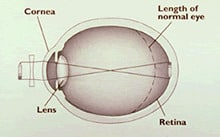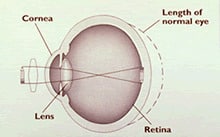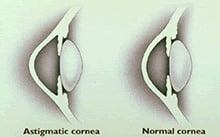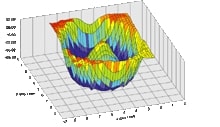What is a Refractive Error?
In normal vision, light enters the eye through the cornea and is focused at a single point on the retina at the back of the eye.
With a refractive error, there is a defect in the way light passes through the eye. Light rays do not refract (bend) properly to achieve a single focus point. Instead, light rays focus in front of the retina (nearsighted), behind the retina (farsighted), or at two different points (astigmatism). Refractive errors usually result from a defect in the length of the eye or shape of the cornea.
- Myopia or Nearsightedness: Close objects are seen clearly but distant objects appear blurred. Myopia is caused by a steeply curved cornea or elongated eye.

- Hyperopia or Farsightedness: The cornea is often too flat and light rays focus behind the retina. Both near and distant vision are usually blurry.

- Astigmatism: The cornea is irregular and egg shaped, causing light rays to focus at multiple points and resulting in blurred or double vision at all distances.

What is Laser Light?
Lasers use light beams that are made from a single color or wavelength of light and which have all of the light rays traveling in the same direction (coherent light). Laser light is not radiation, as are x-rays, cosmic rays and gamma rays. The light itself is safe and does not become effective in medical treatment until it becomes highly concentrated through the use of special mirrors and lenses.
Laser light reaches its maximum strength at the focal point, the point where all the rays converge. The strength of the beam rapidly diminishes after passing the focal point, and can no longer affect other tissues in the eye.
The Excimer Laser
Instead of using heat to alter tissues like other lasers, an excimer laser beam breaks the bonds that link tissues together with only minimal effect on surrounding tissues. These unique properties allow the excimer laser to be used in the LASIK procedure to reshape corneal tissue. After LASIK, light rays focus more precisely on the retina.
The LASIK Procedure
A special instrument (a microkeratome) is applied to the cornea, creating a thin flap of corneal tissue. The flap remains attached to the eye at one end. Next, the laser is used to reshape the cornea.
Wavefront Technology

Wavefont technology allows surgeons to perform customized LASIK, LASEK and other refractive surgeries using information gathered from the patient’s own eyes. During a pre-operative examination, light is projected onto the retina and a set of measurements called a wavefront is created.
Data obtained from the wavefront exam is converted into a waveprint, a unique profile of the patient’s optical system that is as personal as a fingerprint. Using the results of the wavefront procedure, surgeons can correct the particular refractive errors that obscure the patient’s vision.
Eye Tracker
During laser vision correction surgery, laser pulses must be accurately placed to reshape the cornea. A challenge to this procedure is the patient's constant eye movement. A person's eyes make small, involuntary movements known as saccadic movements about 100 times per second. Since the saccadic movements will not stop during the surgery, most excimer laser systems use an eye-tracking device that measures the movements and guides the placement of the laser beam.
CustomVue™ LASIK
VISX™’s CustomVue procedure combines the technologies of the WaveFront and STAR S4 Excimer Laser systems for high-definition, high-accuracy LASIK vision correction.

Benefits of the CustomVue process include faster treatment time, elimination of need for pharmacological pupil dilation, minimal heating of the cornea, capability of ignoring errors arising from torsional eye movements, variability of beam size and depth during spot scanning, and individualized treatment with images based on hundreds of data points gathered from each patient’s pupil.
An FDA clinical study reports that six months after the VISX CustomVue™ procedure:
- 100% of participants could pass a driving test without glasses or contacts
- 94% of participants could see 20/20 or better without glasses or contacts
- 74% of participants could see better than 20/20 without glasses or contacts
20/20 is the current standard for excellence in vision. But, with the CustomVue™ procedure, individuals have the potential to see even better than 20/20. In fact, six months after the CustomVue procedure more than 74% percent of clinical study participants saw 20/16 or better.
Many patients found their night vision was improved after the CustomVue procedure. In fact, in the clinical study, four times as many participants were very satisfied with their night vision after the procedure as compared to their night vision before with glasses or contacts.
Intralase
Intralase LASIK, also known as Femto-LASIK or All-Laser LASIK, is a form of refractive eye surgerysimilar to LASIK that creates a corneal flap with a femtosecond laser microkeratome rather than with a mechanical microkeratome. The only difference between LASIK and Intralase Lasik is the method by which the Lasik flap is created. The actual refractive correction by corneal ablation can then be performed with excimer laser that is able to perform Lasik, including conventional, wavefront-optimized, or wavefront-guided ablation.
Before the excimer laser reshapes the cornea to improve vision, your doctor must create a corneal flap, a fine layer of corneal cells that is lifted and folded back out of the way. The Intralase laser can make a thinner flap than the microkeratome, this enables more people, with thinner corneas to take advantage of Lasik eye surgery. Some people who have thinner corneas and were unable to have Lasik eye surgery before can now have the procedure using the this new technology.
Intra Lasik is the same as Lasik except the flap is created with the Intralase laser rather than with a microkeratome.


